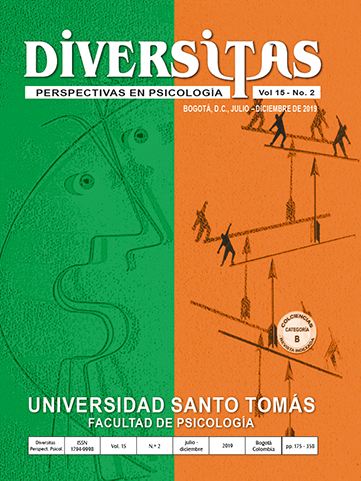Tamaño del grupo, argumentación y lectura de tablas en estudiantes universitarios
Group size, argumentation and table reading in university students
Abstract (en)
Argumentation is an important variable to understand the learning process. Despite there are several papers about it, its relation with the group size is a novelty. The relationship between the group size (dyad-triad) and the argument distribution (symmetric-asymmetric) in a double-entry table reading task, in addition to its relationship with the type of answer used, are analyzed. A quasi-experimental design was used with only a post-test, in a sample of 89 university students. The results show that the dyads obtained the highest values of symmetry, whereas the triads obtained higher values of asymmetry. No significant relationships were found between the group size and the final answers types, neither between the group size and the answer type. This would indicate that the size of the group affects the possibility of people to provide arguments during the interaction, as well as the type of task that would condition the type of arguments used.Abstract (es)
References
Arteaga, P., Batanero, C., Cañadas, G., & Contreras, J. M. (2011). Las tablas y gráficos estadísticos como objetos culturales. Números, 76, 55–67.
Asterhan, C. S. C., Scwartz, B. B., & Cohen-Eliyahu, N. (2014). Outcome feedback during collaborative learning: contingencies between feedback and dyad composition. Learning and Instruction, 34(1), 1-10.
Baker, M. J. (1998). Interpretaciones argumentativas y aprendizaje cooperativo. Revista del Centro de Ciencias del Lenguaje, 17, 133-167. Baker, M. J. (1999). Argumentation and constructive interaction. Studies in Writing, 5, 179-202.
Billig, M. (1989). The argumentative nature of holding strong views: a case study. European Journal of Social Psychology, 19, 203-223.
Capraro, V. & Barcelo, H. (2015). Group size effect on cooperation in one-shot social dilemmas II: curvilinear effect. PLoS ONE, 10(7), 1-11. http://dx.doi.org/10.1371/journal.pone.0131419
Castellaro, M. & Roselli, N. (2014). Estudio exploratorio de la interacción colaborativa infantil en la realización de dibujos libres. Pensamiento Psicológico, 12(2), 37-56.
Castellaro, M. & Roselli, N. (2017). Interacción sociocognitiva entre pares en situaciones simétricas y asimétricas de competencia epistémica. Revista de Psicología, 36(1), 1-18.
Erduran, S., Simon, S., & Osborne, J. (2004). Tapping into argumentation: developments in the application of Toulmin’s argument pattern for studying science discourse. Wiley Interscience, 88, 915-933. http://dx.doi.org/10.1002/sce.20012
Gabucio, F., Martí, E., Enfedaque, J., Gilabert, S., & Konstantinidou, A. (2010). Niveles de comprensión de las tablas en alumnos de primaria y secundaria. Infancia y Aprendizaje, 22(2), 183-197.
García-Mila, M., Gilabert, S., Erduran, S., & Felton, M. (2013). The effect of argumentative task goal on the quality of argumentative discourse. Science Education, 97(4), 497–523.
Khun, D. & Udell, W. (2003). The development of argument skills. Child Development, 74(5), 1245–1260.
Martí, E. (2003). Representar el mundo externamente. La adquisición infantil de los sistemas externos de representación. Madrid, España: Antonio Machado.
Marti, E., García Mila, M., Gabucio, F., & Konstantinidou, K. (2011). The construction of a double-entry table: A study of primary and secondary school students’ difficulties. Eurpean Journal of Psychology of Education, 26, 215–234.
Mugny, G., Perret-Clermont, A. N., & Doise, W. (1981). Interpersonal coordinations and sociological differences in the construction of the intellect. Progress in Applied Social Psychology, 1, 315-343.
Peralta, N. & Castellaro, M. (2018). Interacción e Intersubjetividad: Investigando sus beneficios en el ámbito educativo. En J. Faccendini, P. Martino, M. Sironi y M. Terrádez (comp.), Caleidoscopio. Prácticas y Clínicas Psi en la Universidad (pp. 247-259). Rosario: UNR Editora.
Peralta, N. & Roselli, N. (2017). Modalidad argumentativa en función del tipo de tarea y tamaño del grupo. Cogency, 9(2), 67-83.
Piaget, J. (1972). Psicología de la inteligencia. Buenos Aires, Argentina: Psique (Año de publicación del original: 1947).
Piaget, J. & Inhelder, B. (2015). Psicología del niño. Madrid, España: Morata (Año de publicación del original: 1967).
Resnick, L. B., Salomon, M., Zeitz, C. M., Wathen Haley, S., & Holowchak, M. (1993). Reasoning in conversation. Cognition and Intruction, 11, 347-364.
Rips, L. J. (2002). Circulate reasoning. Cognitive Science, 26, 767-795.
Rodríguez Andoval, F. & Sandoval Rubilar, P. R. (2012). Habilidades de codificación y descodificación de tablas y gráficos estadísticos: un estudio comparativo en profesores y alumnos de pedagogía en enseñanza básica. Avaliação, 17(1), 207-235.
Roselli, N., Dominino, M., & Peralta, N. (2010). Influencia del tipo de tarea sobre la interacción colaborativa en equipos virtuales. Revista de Psicología General y Aplicada, 63(1), 97-117.
Tauber, L. M. (2010). Análisis de elementos básicos de alfabetización estadística en tareas de interpretación de gráficos y tablas descriptivas. Ciencias Económicas, 8(1), 53-74.
Tudge, J. (1989). When collaboration leads to regression: some negative consequences of sociocognitive conflict. European Journal of Social Psychology, 19, 123-138.
Tudge, J. (1992). Processes and consequences of peer collaboration: A vygotskian analysis. Child Development, 63, 1364-1379.
Wu, H. K. & Krajcik, J. S. (2006). Inscriptional practices in two inquiry-based classrooms: a case study of seventh graders’ use of data tables and graphs. Journal of Research in Science Teaching, 43(1), 63-95.
How to Cite
License
Diversitas Journal is under license Creative Commons Atribución-NoComercial-CompartirIgual 4.0 Internacional (CC BY-NC-SA 4.0)







